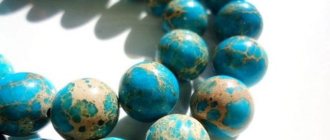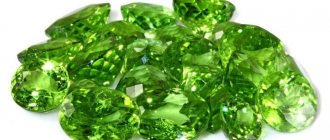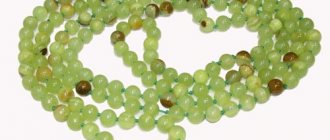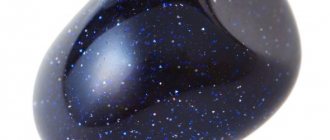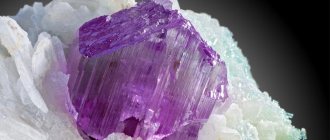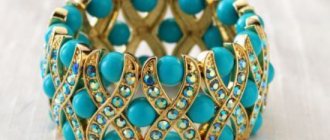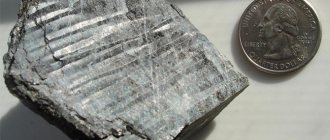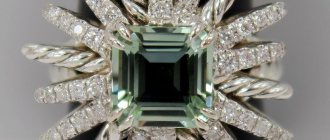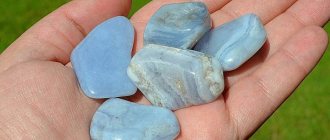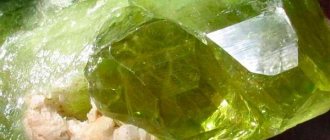Fuchsite (fuchsite - English) is chrome mica, also known under such names as:
- Verdit;
- Green muscovite;
- Chrommuscovite;
- Mica slate;
- Gebhardite;
- African gold.
Its modern name is not officially recognized, but still in all scientific studies the stone appears under this name.
Origin story
It received its name from the Bavarian mineralogist Johann N. von Fuchs, who studied mica in an attempt to obtain soluble glass. The second name of the rock is “muscovite”; it comes from the distant Middle Ages. Then the supply of the mineral was organized from Moscow to European countries and the locals called Moscow glass “moski”, later replacing the letter “o” with “u” in conversation.
The American called it “mariposite”, the French “celadonite”, and the Italians “verdit”. Scientists suggest that all the names are associated with mica deposits, and the Italian rock generally has some differences from fuchsite.
Description and external signs
Hearing the name fuchsite, everyone will first of all think of a bright pink flower - fuchsia, which is why one can mistakenly assume that the name of the mineral is directly related to its color characteristics, but this is completely wrong. The stone received its name thanks to the famous mineralogist who studied the methods of producing metamorphic glass, J. von Fuchs.
Fuchsite is one of the varieties of muscovite. They differ from each other only in that fuchsite contains chromium, which gives the stone a green color, while muscovite cannot boast of a noble color: its crystals are transparent.
Muscovite is a potassium mica that is widely used in glass production, radio engineering and electronics. It received its name in honor of the city of Moscow (“Muscovy” - muscovite), from which in the Middle Ages it was supplied throughout the globe.
Deposits and production
Rich deposits have been recorded in the Ural Mountains, in the area of the Berezovsky mine. The rock also occurs in other countries - Africa, the USA, Canada, Australia, Karelia, India, Brazil, China and the Kola Peninsula.
The physical characteristics of the mineral differ somewhat, taking into account the depth of the layers and the composition of impurities. However, in general the breed has similar properties.
Classification
The most famous varieties of the mineral are considered to be stones such as:
- Listvenite is a bright green or gray-green gemstone, a rock that is a mixture of carbonates with quartz and chrome mica.
- Aventurine - in addition to the fact that this mineral is a type of fuchsite, it is also classified as quartz rocks. It has a dark gray or black tint with small inclusions of shiny crystals.
- Verdite is a bright green stone, chemically 90% identical to fuchsite. It got its name because of its optical characteristics (verde - green).
Chemical composition
Chromium oxide is the main component that determines the optical characteristics of the stone. Chromium is present in its composition in an amount of 4-6% and this is enough to color the mineral in an intense green tint.
Chemical formula of chromium mica: KaAl2[AlSi3O10](OH)2
In nature, it is most often found in association with such nuggets as:
- Kyanite;
- Ruby;
- Pomegranate;
- staurolite
It may also contain tiny emerald crystals.
Physical properties
| Property | Description |
| Color | green, emerald, green-gray, green-brown, marsh |
| Cleavage | perfect |
| Shine | pearlescent, matte |
| Transparency | transparent, translucent |
| Specific gravity | 2.7 – 3.1 g/cm 3 |
| Kink | elastic |
| Hardness | 2-3 according to Mohs, in verdite state - 7 |
| singonia | monoclinic |
| Class according to the USSR system | silicates |
| Crystals | tabular, lamellar |
| Behavior in acids | insoluble |
| At temperatures | loses water when heated above 850C o |
Production (field)
| Field | A country |
| Belgorod region | Russia |
| North Caucasus | Russia |
| Rep. Crimea | Russia |
| Northern and Polar Urals | Russia |
| Karelia | Russia |
| Quebec | Canada |
| California, Colorado | USA |
| Tasmania | Australia |
| Zimbabwe | Africa |
physical characteristics
This is primarily mica, which according to its characteristics corresponds to layered silicates. Contains a high content of many impurities, but most of all chromium, from 4%.
Natural material has high elasticity. The hardness is low, it has the property of electrical conductivity and light refraction. Fuchsite plates melt at a temperature of 10,000 °C.
However, elasticity and flexibility are noticeable even at temperatures from 18 ° C. If a stone is exposed to sunlight for a long time, then gradually its structure will begin to exfoliate, and the surface itself will change color.
Characteristic
The green mineral is distinguished from muscovite by the presence of chromium, which replaces aluminum in the molecule of the compound. In muscovite, the chromium content is much less than in fuchsite, which contains from 4 to 6% chromium oxide. Chromium in muscovite can change the optical effect, while in fuchsite there is pleochroism with a modification of color from colorless to deep emerald. Depending on the presence of chromium, a higher content implies a greater refraction of the light beam in the fuchsite. There are minerals with large zones of pink-red stone; these are red corundums in a massif of fuchsite ore. Such stones are often fissured and heavily colored. Still very rare, but still found in layers of green mica, not jewelry emeralds.
Medicinal properties
Lithotherapists often use fuchsite to remove toxins and poisons from the body. Also, under its influence, it is possible to normalize the composition of the blood and eliminate problems of the hematopoietic system. Accelerate wound healing, the process of stopping blood, that is, accelerate clotting.
Cure diseases of the skeletal system and joints. Reduce symptoms of severe physical injuries. Eliminate spinal curvature. Lithotherapists suggest that there are many more healing properties, they just have not been fully studied.
In general, under its influence you can find psychological harmony and recover from mental wounds. Increase the functioning of the immune system. Eliminate insomnia, drive away unjustified anxiety and anxiety. At the same time, it is recommended to use it to treat injuries and eczema of the skin.
Physical properties of the mineral
Mica has been known to people since ancient times. In the Middle Ages, its main supplier to European states was Muscovy, which the Italians called “Musca”. It is from this word that the name “muscovite”, used to refer to mica, comes from. For a long time, the British called the mineral “Muscovite glass.” Later, the stone began to be called potassium mica, white mica, cat silver, batchelorite, Moscow star, shernikite, antonite, etc.
The mineral muscovite is a translucent mica whose color varies from completely transparent and white to green and brown. The crystal lattice of the rock is made up of tetrahedrons, forming endless rows. They are based on aluminum, silicon and water, connected to each other by potassium ions. Muscovite easily splits into thin elastic-flexible leaves.
Since it is mica, its description is largely the same as talc. In order not to confuse these types of stones, you need to pay attention to their leaves. In talc they lack elasticity, and this is its main difference from muscovite.
The physical properties of mica are manifested in very perfect cleavage and low hardness (only 2-2.5 units on the Mohs scale). Other distinctive features of the mineral are:
- glass pearlescent luster;
- elasticity;
- refractive index - 1.6;
- density about 3 g/cm³;
- many-sided syngony;
- high electrical insulating properties.
Magic properties
Like any rock, fuchsite is distinguished by a number of magical properties that allow its owner to make his life better:
- stimulates creativity;
- inspires;
- increases self-esteem, strengthening fortitude;
- allows you to develop a sense of intuition;
- activates the enhanced work of the subconscious, preventing the making of wrong decisions.
Ancient shamans used the magical properties of mica to enhance the magical abilities of other stones. It was also used in rituals to increase productivity.
Green mineral to help people, or magical properties
The healing properties of muscovite are manifested in promoting stability in all areas. Helps with dizziness, insomnia, impotence, infertility, and also with diseases of the upper respiratory tract. Able to cleanse the blood of toxins.
Shamans are confident in the incredible power of this stone, and in order to heal a person, they use it to enter a trance, thus learning the cause of diseases. Shamans also consider muscovite a symbol of the fertility of the earth and people.
Along with this, the layered stone is credited with the property of ridding a person of an inferiority complex, the crown of a loser. Allegedly, the owner of the stone will no longer be visited by thoughts: “Everything good is not for me, I’m unlucky.” It is also strongly recommended to purchase a mica product for weak people who are poorly protected from negative energy flows.
Meaning of Zodiac Signs
As a talisman, products with fuchsite are allowed to be worn by absolutely all signs of the zodiac circle; this is exactly what modern horoscopes say. However, the stone has a special effect on a person if he was born under the sign of Pisces, Libra, Aquarius.
The mineral will allow its owner to reveal a lot of unique abilities. With him it is easy to climb the career ladder, make new connections, and open projects. Under his influence, success and material wealth quickly come. To improve productivity and attract family well-being, magicians recommend having products made from this assistant in their homes.
In what deposits is it found?
Pure mineral, without impurities, is not mined so often; in deposits it is usually present in combination with aluminosilicates, feldspar and quartz. All the world's stone experts value optically excellent stones with the obligatory fuchsite content. For example, green aventurine is essentially quartz consisting of muscovite crystals. This green aventurine is sometimes called fuchsite, when it would be more logical to call it “fuchsite quartzite.”
The most beautiful, ornamental stone, including fuchsite, calcium carbonate and other minerals, is called listvenite. This mineral is being mined in the Urals, however, this deposit is only one of many places where green marble is mined.
In the Southern Alps and on the northern shores of the Mediterranean, the most magnificent cippolino marble is mined. It has a pronounced plastic structure with a natural imprint. This pattern is caused by fuchsite layers in the carbonate massif, in the form of a branched pattern.
Applications and products
Of course, the color of fuchsite is delightful, but in jewelry it is practically not valued. Sometimes used to make necklaces and bracelets. Wider use is noted in ornamental arts.
Various figurines of animals, mythical creatures, figurines, stands, balls, and other interior items are made from it. Products made from rock, after proper processing and polishing, acquire a unique shine, the patterns become more expressive and bright.
On a large industrial scale it is used to produce chromium. The field of mechanical engineering uses metal impurities obtained from minerals. Such metals are suitable for the production of acid-resistant, stainless steel. Often, admixture components obtained from the mineral are added in the manufacture of paints, as well as in pottery.
Description of fuchsite stone
Shades of green make up the color range of fuchsite. There are brown, lilac versions, as well as specimens with a bluish tint, which are characterized by a matte or pearlescent sheen. The stone is almost completely transparent, so it is perfectly translucent.
It is very rare to find a pure stone. Typically, fuchsite is an inclusion in vein quartz and forms a separate variety called “aventurine.”
In its appearance, fuchsite resembles chrome diopside and uvarovite. They also contain a significant amount of chromium molecules.
The mineral has a rich emerald hue. However, jewelry makers rarely work with it. In stores you can occasionally find necklaces and bracelets made from it. Stone is used more often as an ornamental material. Fuchsite is used to create figurines, balls, stands and other items. After the polishing process, its surface is highly shiny. And the pattern of the gem acquires brightness and exclusivity.
Storage and care
Given the fragility of the material, products with fuchsite must be protected from prolonged exposure to sunlight. Otherwise, it will burn out, begin to peel off and gradually collapse. It is important to protect from shocks and temperature changes.
Jewelry is stored in special bags and boxes. When cleaning, use only a damp cloth soaked in plain water. After wet wiping, be sure to wipe dry and polish with a cloth.
Application of fuchsite
Rocks with fuchsite inclusions have been of interest to humans for a long time. A vase made of greenish mica dating back to the third millennium BC was found in Pakistan. Research has shown that the vase was made with the presence of fuchsite.
Today, breeds with fuchsite are used to make interior decorations. Fuchsite is a mineral that is very unstable to the sun and aggressive environments, so it is very rarely used to make bracelets and beads.
On a production scale, fuchsite is used in electrical engineering (dielectrics) and for the production of varnishes and paints (filler). Also applicable as a source of chromium.
Application of muscovite in industrial production
Muscovite is an excellent dielectric, widely used as a direct current insulator. Large-crystalline varieties of stone are used in the production of radio and electrical goods. The mineral is used in the creation of modern energy plants. Electrical insulating gaskets made from it are used in the manufacture of electrical devices. Muscovite sheet serves as a raw material for the production of capacitors and telephones.
Mica is used to make powder, which is subsequently used to make building materials, heat-resistant paints, car tires and glass, mica cardboard, wallpaper, and writing paper. Mica-muscovite is a component of grinding stones and lubricants. In the metallurgical industry, windows for blast furnaces are made from the mineral.
The use of mica is a necessary condition for the creation of mycalex, a heat-resistant material obtained from a mixture of muscovite and fusible glass. Its use makes it possible to create circuit boards, inductor combs, high-power lamp holders and other parts used in modern electrical and radio equipment.
